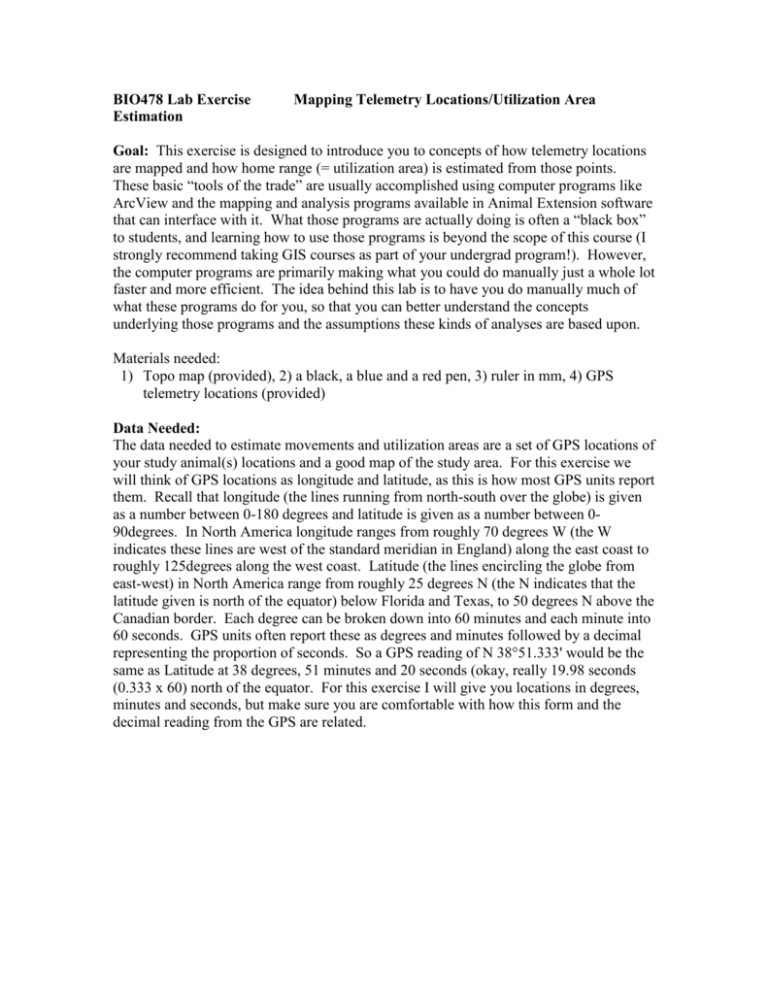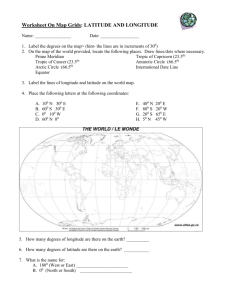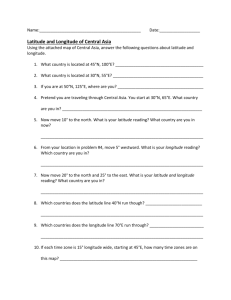Home Range/Utilization Area Lab Exercise
advertisement

BIO478 Lab Exercise
Estimation
Mapping Telemetry Locations/Utilization Area
Goal: This exercise is designed to introduce you to concepts of how telemetry locations
are mapped and how home range (= utilization area) is estimated from those points.
These basic “tools of the trade” are usually accomplished using computer programs like
ArcView and the mapping and analysis programs available in Animal Extension software
that can interface with it. What those programs are actually doing is often a “black box”
to students, and learning how to use those programs is beyond the scope of this course (I
strongly recommend taking GIS courses as part of your undergrad program!). However,
the computer programs are primarily making what you could do manually just a whole lot
faster and more efficient. The idea behind this lab is to have you do manually much of
what these programs do for you, so that you can better understand the concepts
underlying those programs and the assumptions these kinds of analyses are based upon.
Materials needed:
1) Topo map (provided), 2) a black, a blue and a red pen, 3) ruler in mm, 4) GPS
telemetry locations (provided)
Data Needed:
The data needed to estimate movements and utilization areas are a set of GPS locations of
your study animal(s) locations and a good map of the study area. For this exercise we
will think of GPS locations as longitude and latitude, as this is how most GPS units report
them. Recall that longitude (the lines running from north-south over the globe) is given
as a number between 0-180 degrees and latitude is given as a number between 090degrees. In North America longitude ranges from roughly 70 degrees W (the W
indicates these lines are west of the standard meridian in England) along the east coast to
roughly 125degrees along the west coast. Latitude (the lines encircling the globe from
east-west) in North America range from roughly 25 degrees N (the N indicates that the
latitude given is north of the equator) below Florida and Texas, to 50 degrees N above the
Canadian border. Each degree can be broken down into 60 minutes and each minute into
60 seconds. GPS units often report these as degrees and minutes followed by a decimal
representing the proportion of seconds. So a GPS reading of N 38°51.333' would be the
same as Latitude at 38 degrees, 51 minutes and 20 seconds (okay, really 19.98 seconds
(0.333 x 60) north of the equator. For this exercise I will give you locations in degrees,
minutes and seconds, but make sure you are comfortable with how this form and the
decimal reading from the GPS are related.
For this exercise I have provided a topo map of a region of Arizona on the accompanying
sheet. Note that topo maps come at different scales, this is a 7.5 minute series, one of the
finest scales available. Note also that in the upper right hand corner you have the
longitude and latitude given in degrees (°), minutes (') and seconds (''). So where is this
anyway? Some online resources you should be aware of are the free map resources
available on websites like that at Google Earth and Terraserver. For this exercise, we’ll
use Terraserver. Go to http://terraserver.microsoft.com/. In the top right toolbar click
“advanced find”. In upper right corner of the “advanced find” window, click on DMS
(next to “decimal degrees”). Type in the latitude and longitude at the top right of the topo
sheet provided. Hit GO
You should have an aerial photo of the area. Does it look familiar? Click on the Topo
Map tab at upper right. You should have a topographic map of the site that you can
download, print etc. Know where you are? Hit the round “zoom out” button (upper left)
until you can see landmarks that allow you to place the position of this study site relative
to Flagstaff. Cool resource, eh? Print off a map and turn it in next lab period so I can see
that you actually did this.
Okay now to business. You will be provided with an EXCEL spreadsheet of
telemetry locations for elk. Your job is to map these locations. You could turn to
ArcView, but let’s do it by hand to see how ArcView does this. First we need to grid out
our degrees and minutes so we can locate elk positions on our topo map. Along the top
of the map, you will see 111°00' in the top right corner. This represents 111°00'00'' W.
As you move left of this, longitude will get bigger. Toward the left hand upper corner
you will see the numbers 2'30'''. The short line under this number represents 111°02'30''.
Ah ha! Between the right-hand edge of the map and this point we span 2 and a half
minutes (or 150 seconds) of longitude. So you could simply measure the distance
between these two points, divide by 150 and you would have the distance on the map that
represents 1 second of longitude. I have done this for you (but you can check me if you’d
like) and came up with roughly 1.06mm per second or 10.5 mm =10 seconds). Okay so
measure from the left corner in increments of 10.5mm and USING A BLUE PEN draw a
vertical line through the map extending down from each point. Make sure these lines are
parallel with the side of the map! Then label above these 4 lines that represent
111°00'30''W; 111°01'00''W; 111°01'30'' W; 111°02'00'' W (this should leave two
unlabeled lines between each labeled line). Okay now you have longitude references,
now we need the same for latitude. I had to fudge the top of the map, so your reference
point for starting the grids is 34°20'00'' N. Look along the right-hand edge of the map
and find where it says 20' (about 2/3 of the way down). A line drawn horizontally across
the map at this point would represent 34°20'00'' N. Once again we could measure
between this location and the next to determine the distance a degree of latitude is on this
map, but again I did this for you, and 10seconds of latitude equals roughly 16mm on the
map. Starting at the point labeled 20' measure up and down from there in increments of
16mm and then draw horizontal lines across the map at each point in BLUE PEN. These
lines should be parallel with the bottom of the page and at right angles to the longitude
lines you just drew. Label the lines representing 34°20'30'' N; 34°21'00'' N going up from
the line representing 34°20'00'' N, and 34°19'30'' below the line representing 34°20'00''
N. Whew! We have our grid and are ready to plot our elk positions.
Plot each location as a dot on your map using the RED PEN. Label each location with
the Location Number (these are simply the numbers from 1-10 in the EXCEL sheet).
Cool, you’ve just graphed the locations of your animal through time.
Calculating Home Range/Utilization Area. Some of the most fundamental questions
you can ask about a species are: 1) How much area does one animal need? 2) What kind
of habitat does it use? 3) How does the area it needs change with habitat type, time or
climate? 4) How does the area used change with human development of houses, roads or
forest treatment? All of these questions (and many more) are often addressed by
throwing transmitters on animals and then using their locations to tell us something about
how they are using space. Everybody has an idea of what “home range” means but it’s
difficult to define. The most widely accepted definition is “the area an animal uses in the
course of its daily activities”. But if an animal moves seasonally, like a migratory bird,
do you include both its winter and summer activities? Do we mean the range used when
an animal is breeding? Or during non-breeding seasons? Those areas could be very
different in size. Recently folks have started avoiding this term and using “utilization
area” instead and then defining the period over with the area was utilized. Just be aware
that the term “home range” has some controversy surrounding it.
So how does one estimate what a utilization area is? We will look at two
approaches.
MCP. The simplest is called the minimum convex polygon (MCP) or some variation on
this. To get the MCP utilization area, you literally connect the dots. Just draw a line
between all of the outermost locations so that the polygon that results includes all the
points (See attachment). Do this for your elk locations using the RED PEN.
Density/Probability/Kernel Estimators. The other approach is to somehow represent
the clumping that normally occurs with telemetry locations. Clearly there are some areas
with lots of locations and some with very few. There are a number of ways to do this
using various mathematical algorithms. For our purposes, we will illustrate the concept
by simply drawing two lines. First draw a SOLID BLACK line around the 9 locations
that are closest together, so that your utilization area now encompasses the 90% of points
that are closest together. We could think of this as a 90% polygon, and algorithms that
calculate the 90% probability of occurrence are often reported in utilization area studies.
Now draw a DOTTED BLACK line around the 5 locations that are closest together. We
could think of this as the 50% utilization area, where you might expect to find an animal
at least 50% of the time. These are often called “core areas”. Although the 90% and 50
% cut-offs are often used, note that these selections are arbitrary. We could just as easily
pick 95% or 75%. Note that one way we could describe use is based on the density of
locations in different areas. We could place a grid over the whole map and count the
number of locations in each grid square and then color in each square with a color
representing the density of points. In some cases, utilization areas will be represented by
this type of density map (See attachment). All it is representing is this differential spread
of points across space.
Discussion/Critical Thinking Points (these will be used as the basis for lab exam
questions)
1) How would you describe the pattern of use based on your data? Is there a
single area of high use? Are there multiple utilization areas? Based on the
topo map, how would you describe the habitat your animals are using? Flat?
Steep slopes? Near other physical features? What do you know about elk
that could explain this spatial pattern?
Be ready to present your results to the class.
2) What are the advantages and disadvantages of the two approaches to
describing utilization areas? How do the MCP, 90% and 50% approaches
compare in terms of their estimated size of utilization area?
3) How could the way in which telemetry locations were collected affect
estimates of utilization areas? What factors would be most important to
control?
Telemetry locations
Density Measures
Minimum Convex Polygon
Telemetry locations can be used to create home range/utilization areas based on
minimum convex polygons (MCP) or as some sort of density (kernel) estimators








